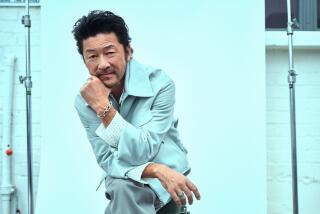Bamboo : These Shoots Are Somis Nurseryman’s Pride and Passion
- Share via
Kiyoshi Yoshida has a passion for bamboo.
He dreams of planting bamboo where the eucalyptus grove now stands along U.S. 101 in Camarillo. His Somis Bamboo Garden is a Mecca for collectors of the plant who come from all over the world to inspect Yoshida’s rare varieties. And, when he dies, Yoshida wants his ashes scattered not over the ocean, but among, yes, bamboo.
Yoshida, 53, is happiest when he can share his adored flora with others. He provided bamboo for a rain forest that stands before the new Museum of Contemporary Art. And it was Yoshida to whom the owner of a 24-foot-diameter, clover-shaped home in Woodland Hills turned when he needed tall, dramatic plants.
But Yoshida, who besides his personal bamboo grove owns a wholesale nursery with his brothers in Camarillo, didn’t really appreciate bamboo until he was sent on a difficult mission in 1964 by his mother, Tame. The 68-year-old woman asked Kiyoshi, the youngest of her six children, to plant a moso bamboo grove behind the family home and nursery in Carson.
Rare in United States
Never mind that moso, the largest of the giant bamboos, was nearly unobtainable in the United States.
“She was my mother, she was my boss, and I set about to do it,” Yoshida said.
Yoshida went from nursery to nursery to buy moso, whose masses of tiny leaves resemble ostrich plumes. At the end of each growing season, Tame said, “No, Kiyoshi, that’s not moso.”
Yoshida began a scientific study of bamboo and learned the botanical description of moso. It was nowhere to be found on the West Coast.
Then he read about the U. S. Department of Agriculture’s 40 acres of bamboo in Savannah, Ga. It had been developed in the ‘30s to replace the slow-growing pine as a source for pulp to make paper.
The acreage is federal property and digging was allowed during the February growing season. “I got 13 divisions from a parent moso--and three survived. The next year, I returned and got 12, five survived.” He pointed to one of the original Moso.
Tame died in 1976. She didn’t live to see her grove of moso, the one she described to her son from memories of her native, Kobe, Japan.
But Carson was not to be the final home of the moso. In 1980, Yoshida, his wife, Judy, and daughter, Bonnie, moved to Somis, a rural Ventura county hamlet where farming is still the primary activity.
The Yoshida brothers sold the Carson nursery and began a wholesale one in Camarillo. In the acre around his home on La Cumbre Road, Kiyoshi began the Somis Bamboo Garden.
Yoshida takes a visitor through his 50 kinds of exotic bamboo. He is about 5-foot-7, with a compact sturdy build. His “uniform” for home, garden and most occasions is a casual shirt and jeans with rolled up cuffs. Judy, his wife, says “Kiyoshi is a trend setter. He wore them long before jeans were in vogue.”
He is the only full-time nurseryman in the 600-member American Bamboo Society. As such, he is a champion of the plant.
“Twenty or thirty years ago, golden bamboo was overplanted,” he said. “Homeowners couldn’t control the runners. But not all bamboo deserves a bad reputation. Many clumpers and runners are self-confining. So much nonsense about bamboo.”
Challenges Myth
He challenges a popular myth: “It never moves houses. That’s a tale. Just about as honest as saying all Japanese do bonsai. I’m a living example that that’s ridiculous. I don’t know the first thing about bonsai.”
Yoshida touched a moso that was rooted in the ground. “Judy and I measured this one every day during the growing season. We still have the growth chart. It grew for 30 days, sometimes as much as a foot a day.
“Once a moso is up, the diameter is set for that particular culm or stalk. Then new shoots, called rhizomes, come up near the parent plant and some take off.” He stepped gingerly among the new ones.
He recalled the advice of his nurseryman father when others in the field inquired how anything was done. “ ‘Always tell them exactly what you do. They won’t believe you and will do it another way.’ ” But Yoshida wants them to believe him. He wants to popularize bamboo and introduce it to more landscape architects.
Out-of-State Visitors
On a recent Sunday, a car with a Washington license plate pulled into the Yoshida driveway. The owners were a couple who come once or twice a year. They dig new shoots, compare successes and failures of bamboos and join the Yoshidas for a pot of tea.
Inside the Yoshida home, under a poster of seven varieties of bamboo, the bamboo enthusiast gathered an armload of books on the subject. Among these is his treasure, “The Book of Bamboo,” published in England in 1896.
“The English are really the plant hunters,” he said. “In the past, the royalty and the rich people sent scouts all over the world looking for unusual plants.”
Yoshida walked to the front of his property. “I planned to make this a moso grove, a bamboo showplace, one my mom would have loved. Now it’s just my hobby, maybe our retirement income.”






